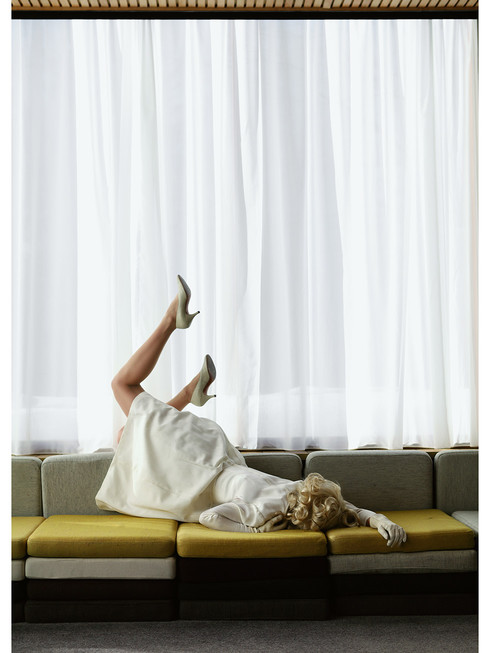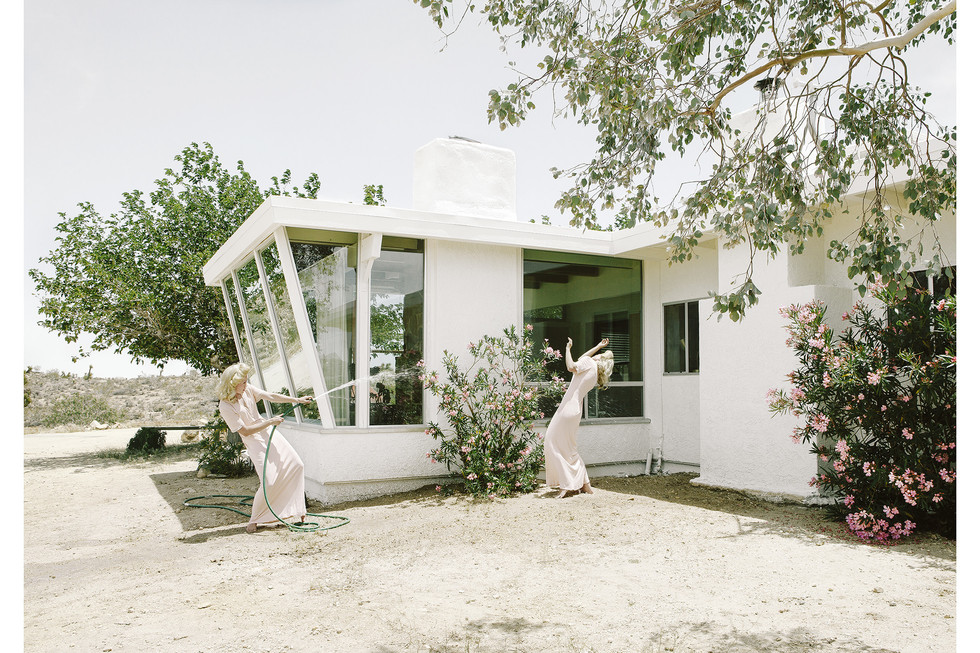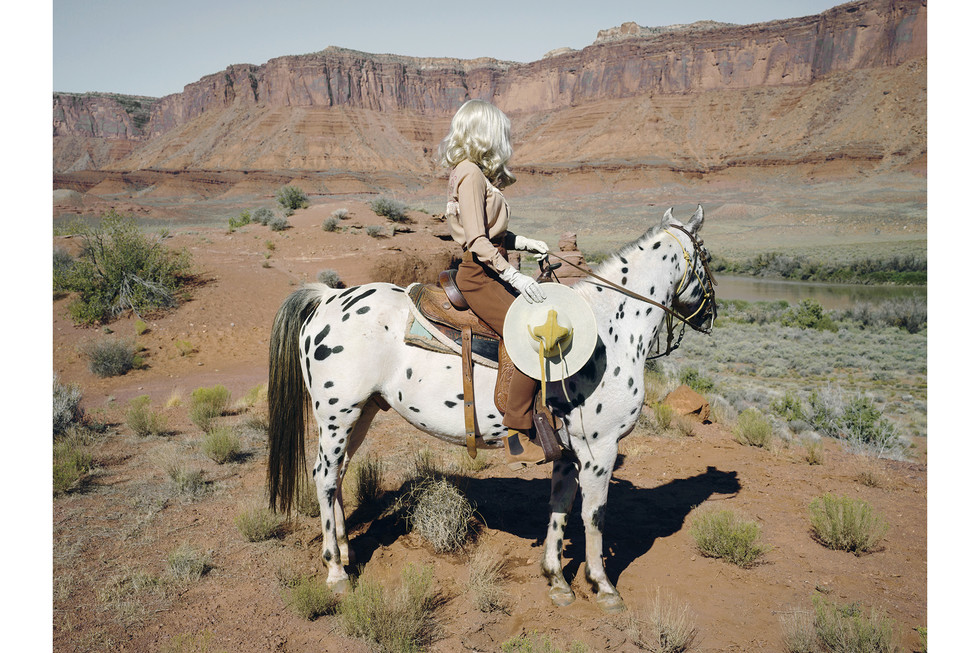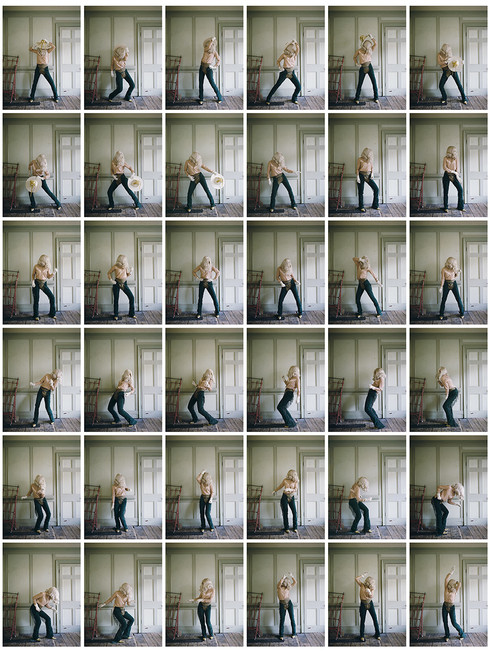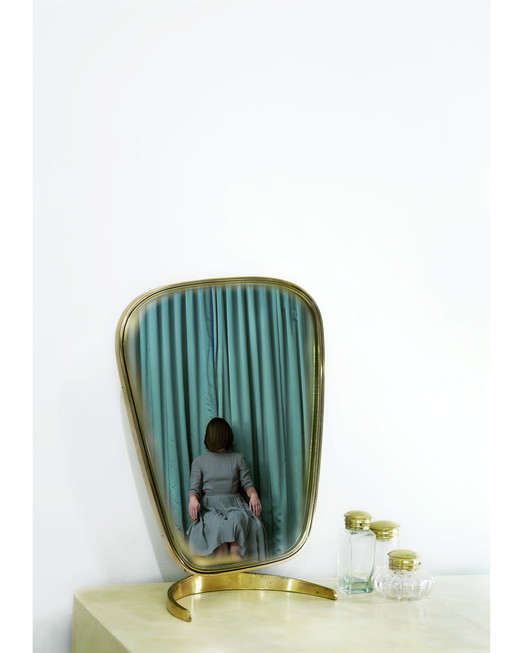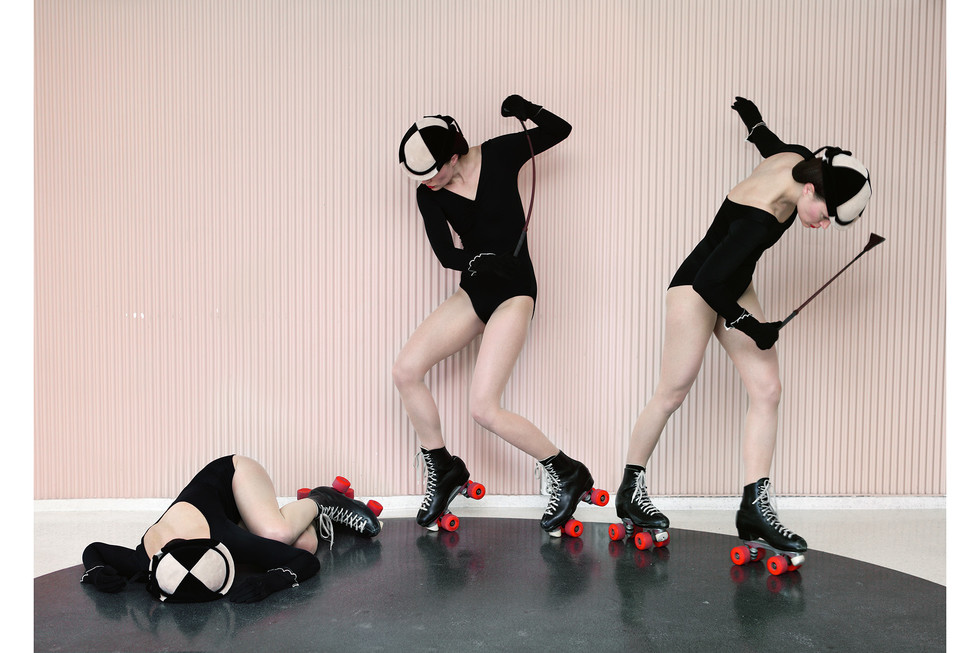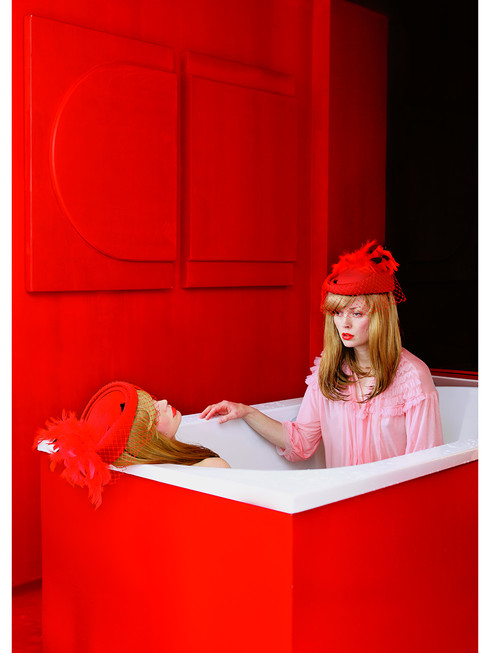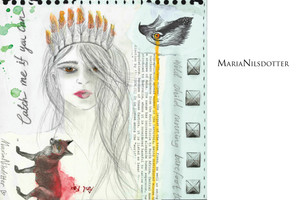THE WORDLESS METAPHOR OF ANJA NIEMI
Written by Ksenia RundinAnja Niemi’s world is a faceless personal story of the film Paris, Texas’(1984) peculiar kind of sadness, accompanied by David Lynch’s neo-noir mystery and wrapped in Francis Scott Fitzgerald’s remarkable melancholic feast of a human fantasy, stretching itself from a luxury hotel in Paris to the blue-grey rocks of Monument Valley in Utah. Being the front figure in Anja’s artworks, the enigmatic blond woman is an expressionless symbol of the inimitable plots, which are narrated by the imagery of marvellous details, divulging a true collector soul of the artist. A kimono from the 1920s, acquired at a vintage shop, a pair of worn-out glittering party shoes, purchased on Ebay and a pink beauty kit from the 1950s, discovered somewhere else online, become pieces of a greater puzzle, making the story complete.
Niemi tells us amazingly intriguing stories without actually saying a word, but painting those with the lens of her camera and the unique wealth of her visual world. In fact, the stories are a looming metaphor about looking for your true self, while doubting and hesitating, loving and devoting, daring and challenging, without giving up your hopes and abandoning your dreams. The transitional nature of the photographs form a bridge between the bold newness of modernity and the scary uncertainty of the ever changing postmodern times by including an endless account of layers that you never get tired of discovering. Beholding Niemi’s artworks provide us an opportunity to become an architect of our emotions and feelings, each time exploring a new intriguing dimension of our visual perception of the world. Following her invincible gut feeling and exquisite artistic taste, Margita Ingwall, PR and Marketing Chief at Fotografiska (a centre for contemporary photography) in Stockholm, kindly introduced the writer of this article to Anja Niemi, what later turned into an alluring and heartfelt conversation.
How did you discover photography as your artistic language?
After I had shot my first film roll, trying to achieve something rather than merely snapping, I think is how I discovered that. Being a creative child, I was always filled with imaginative stories but my dyslexia made me struggle with words. It was not until I attended a photography class at the age of eighteen that I found a tool to tell my stories with. It was the first time the things I saw in my head and the stories I imagined, could be turned into something I was able to show or share. After that I just knew that it was mine.
You have yourself in the photos but at the same time you have made it clear that it is not about you. Who is the woman that you put in the focus?
I think, she could represent anyone and any gender. I want to talk about what it is like to be human, what it is like to be a woman. However, it is, as you mentioned, never about me, I do not find that part very relevant to share. Therefore, I make my characters either faceless or expressionless; sometimes neutral or very exaggerated. It is in order to turn them into symbols rather than real people. Hence, you can project whoever you want and the viewer can identify the character with their own selves.
Since they are all female, I am asking myself whether this is about being a woman. Maybe some of them actually are but, in general, it is a gender-neutral topic about us as people, about emotions and relationships that we have with ourselves. And I do not think those are necessarily gender-specific. Because I am a woman, there are certainly female elements sneaking to it. Especially, it could be visible in my early works, when I was doing a twist on female icons and characters, who we normally see in the movies, directed by men and created by men, allusions and an unattainable ideal. An unattainable ideal is also gender-neutral but it can also become very feminine in a rather exaggerated way. I also find a lot of inspiration in drag queens. It is a mix of things, not just a classic female ideal with certain unwillingness added.
In your series “Darlene and Me” you have two female twins in the picture. Do they represent any kind of alter ego or any archetype?
Yes, they definitely do. And this is something that goes through my work. It is about the relationship we have with ourselves, when it is double or even when it is triple. It is an inner dialogue. That particular series is about one woman and her relationship to herself, where you see her in all the shapes and forms, which such relationship can take. It is quite a brutal connection at times; it is very extreme to all ends of the spectrum.
Actually, a lot of my works start with a clear inspiration and very often it is an object. Being a devoted collector, I collect old things, which once belonged to someone and you can read something out of them. I use character triggers and often include those collected items in a composition. With “Darlene and Me”, it was a beauty counsellor suitcase from the 1950s or 1960s. I ordered it online. It looked really beautiful, containing jars with powder, cream and make-up samples for a door-to-door sales kit. When it arrived, it looked really beautiful with the powder still left in there and you could open those little jars and smell. I did open them all and it created an amazing feeling. Nevertheless, I quite quickly realised that it was so much more than that. It had a clear story to it.
Obviously, my story is partly a fiction, but the woman’s name was written on the papers. So I know something what I did not know for sure was her story. However, what I acquired from it, was an old but, in a certain way, untouched suitcase, where most of the jars were still full and the lipstick looked almost new with the owner’s fingerprints on it. I also looked at the paperwork enclosed to the kit and there were only few receipts. The owner did not really do many sales. When I took a closer look, I realised that the sales she did were to herself. I could see her image as a beauty counsellor, selling the products and as a client, rehearsing her role in a career she might have dreamt about. This is what led me to the character and to the story about how she had struggled and got in her own way. I think, we often do that at a certain stage of our lives, a ‘destroy it all’ feeling. This is how Darlene was born, through a suitcase leading me to her.
How do you prepare for your photo sessions?
My process of getting to the point where I am actually photographing is really long. It is me, the whole process is me. I work alone on everything. When I know what character I want to make, I start collecting things that I assume she would have, finding clothes, wigs and make-up she would wear. It takes some time to complete. Prior to every new story, I clear my studio and start filling it with new items, exclusively belonging to the story. Then I find locations and plan the trip. When I have built up a character and everything is ready, I pack it all up and go to make the images. It takes between one and two years to make a series for me. Finally, when the show is up, I immediately start working on the next series.
Do you conduct the whole styling process by yourself?
This is a building process. I do have a costume collection but for every character you always need new pieces. I know what I need for my character and then I just look through vintage shops, online or anywhere. Mostly, I mix decades to make them timeless, with the exception of ‘The woman Who Never Existed’ maybe. I want the feeling to be genuine to make the character more real to me when I wear them. There is something immersive in using older objects like shoes or clothes, what undeniably comes through. And there is history in them, coming from and created by real people.
What role do you think fashion plays in your artwork, if it does at all?
At the beginning it did not matter for me, but later I started really coming closer to the costumes. Gradually, it became my world through the construction work with the character, while looking for things to complete the image. After I started making this work, I really fell in love with clothes in a new way. Today there is a connection between fashion and art imagery with a lot of inspiration, crossing over both ways.
Don’t you think that you create your own fashion in your photographs by putting clothes in the limelight in a very special way?
At the beginning of my art career I thought a lot about the language of dance, which was more accessible to me than the language of words. I use the body to talk, to tell the story and disclose feelings. I might, as well, be doing it by means of the clothes that I use in my images. It is a body language in connection with the way I dress my character. There is a very different feeling from a cowboy outfit with rough fringe leather chaps to a vintage lace-dress with the lace dripping off the character.
How do you usually scout for locations?
It is pretty straight forward. At a very early stage, when I have a character, a vision appears quite immediately. My world is very visual, it is all images. I see right away what I want it to look like and it is just a matter of searching through everything. Through film sets, through landscapes and houses for sale and for rent, magazines, museums - anywhere where the look will exist.
In the series “Do Not Disturb” I used hotel rooms. I would pack up a selection of costumes, take it all with me and see what would happen in those hotel rooms. I just spent around two days behind those doors in order to make a character. Later, it evolved and became much more specific. And for “Darlene and Me” the images I first got, were connected to that suitcase, sort of putting her into the 1950s time era. But it is never like a period drama, where you have to specifically stick to an era.
“The Woman that Never Existed” was, for example, inspired by an actress, who works in the 1920s. When I first started collecting dresses and kimonos from the 1920s, fans and makeup jars, I suddenly discovered that I did not mind mixing other things. I am not documenting anything specific story but using fantasy, where you can do whatever you want.
Could you please tell more about the series “The Woman that Never Existed”?
This series was sort of a shift in me, because it was the first time where I really had a clear inspiration coming solely from words. Words have always been my enemy. But in this case it was words that actually triggered something. I was reading an article about an Italian actress, who had worked on the theatre stage and in silent movies during the 1920s and 1930s. As a person concerned about her privacy, she never wanted to give any interviews. Once she told to a journalist, “Away from the stage, I do not exist.” Those words just jumped out of the page and I could see a character right away.
This person I started to imagine dissolves or fades away, when no one is looking at her. If she is not directed, having her role or a script, the woman simply does not know what to do. Seemingly, it immediately gave me a new narrative and I started searching for requisites. From the beginning I wanted the plot to look luxurious by adding exclusive fabrics like velvet and silk, frescos. It might seem over-embellished but I did it intentionally, because I wanted to show her world which holds her up and constitutes her allusion. If you took it away from her, there would have been nothing left. She has no facial expressions. Her face is either heavily painted or completely expressionless, reminding of a doll. And that is what she became in my had - an empty shell.
You last series “She Could Have Been a Cowboy” illustrates a completely different world, continent and plot. Where did you photograph it?
I did it in Utah and Arizona. Basically, after I knew what my story was and what I wanted, I collected everything I needed and took a road trip to the American Southwest. I drove for about two and a half weeks by myself, having all those locations preplanned, and my costumes with me. I hiked up mountains and rode horses. The experience becomes a part of the story, I do not turn it to the main point of the images. However, my work process becomes a part of the final product, because the experience of going through it on my own is of significance. My trip to Utah was the biggest challenge so far, it is a very foreign scenery for me, as a girl from Norway. I did not really know how I would feel driving those roads on my own but I certainly knew that it was what I wanted.
I had imagined this character, who dreamt of another life but became stuck in her own reality. The character wears a pink lace-dress, while her fantasy is to be dressed in fringe and leather, while riding horses in the Wild West. There is an image in the series, where you see her sequence repeating itself. It illustrates where she is stuck and what her reality looks like with days repeating themselves and her wearing the same dress. Everything else is just a fantasy built upon things she sees in Western movies and magazines. All the images that I have made represent things she has seen without ever having been to Utah.
I had to go to those classic locations like Monument Valley and the places where John Wayne's films would have been shot. Seemingly, I lived out her fantasies, took that trip and experienced it all, wore the cowboy costume for her. It ended up with an image of the woman sitting on a horse, what actually turned to be my symbol of braveness to dare to be what you really want to be. Her story might have had a sadder twist but, I think, it became something else afterwards. I wanted to create a series that would feel familiar to everyone, who live their life differently to the way they truly want. It could raise the question “Who is stopping you?”
When you were a little girl, could you imagine that one day you would become an artist?
Not being a fabulous illustrator or otherwise showing any special talent, I felt very lost. My sister is a writer, a beautiful writer at that, I remember her making books with exciting stories when she was just seven years old. I was filled with stories too but I did not have the means to express them. I did not do so well in school but I always knew that I had creativity however, I did not really know what I would do with it. For a while, I secretly wanted to be an actress, because of my love for storytelling. But I was very shy and socially anxious, therefore I let it stay a fantasy. With a love for transformation, using my grandmother’s cocktail dresses, I could create a feeling of becoming someone else, someone special. At the age of eighteen, I took a photography class, what I previously mentioned, then I knew. A wordless language became my tool.

